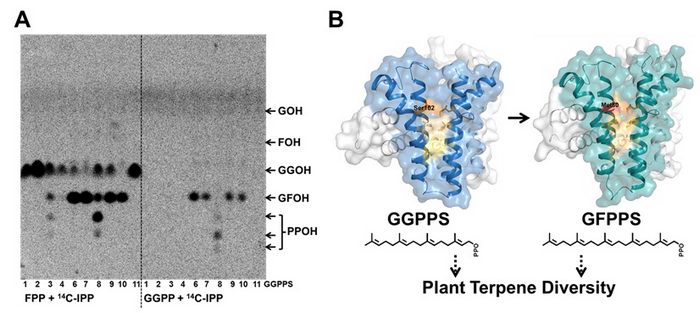Terpenoids are the largest and most diverse group of naturally occurring organic compounds, of which more than 70,000 molecules have been characterized to date. In the plant kingdom, terpenoids function as defense molecules (mono-, sesqui- and di-terpenes), photosynthetic pigments (chlorophylls and carotenoids) and phytohormones (brassinosteroids, gibberellic acid, abscisic acid and strigolactone). In the terpenoid biosynthesis pathway, short-chain prenyltransferases represent the first branch point in the terpenoid biosynthesis pathway, and largely determines the terpenoid diversity. Plants in general, including Arabidopsis, have a multiple genes encoding short-chain prenyltransferase proteins. However, their exact enzymatic activities remain unclear thus far.
Recently, scientists at Dr. WANG Guodong’s Group from the Institute of Genetics and Developmental Biology, Chinese Academy of Sciences, comprehensively analyzed the biochemical and physiological functions of short-chain prenyltransferase gene family (twelve members) in Arabidopsis.
Firstly, they provided solid genetic evidence to support the supposition that heteromeric G(G)PPS (GGPPS11 and 12), and not homomeric GPPS, is involved in monoterpene biosynthesis, at least in flowers of Arabidopsis. They further found that GGPPSL6, 7, 9, and 10 mainly have geranylfarnesyl pyrophosphate synthase activity (C25), which conceivably be used to make sesterterpenes. By solving the crystal structures of three different GGPPSL proteins (collaboration with Dr. ZHANG Peng at the Institutions of the Shanghai Institutes for Biological Sciences, Chinese Academy of Sciences), they revealed the product chain-length determination mechanism of short-chain prenyltransferases and define it as a “three floors” model. Using this model, they identified a novel GFPPS clade distributed in Brassicaceae plants.
In addition, they found that GFPPS genes typically occur in tandem with a gene encoding a TPS, forming a GFPPS-TPS gene cluster. This is the first report of GFPPS from plants, which pave a way for functional identification of new plant terpenoids, sesterterpenes.
The study results were published in Molecular Plant
DOI:10.1016/j.molp.2015.10.010 and). Ph.D student CHEN Qingwen is the first author of these two papers. This work was financially supported the National Program on Key Basic Research Projects (The 973 Program: 2012CB113900 and 2013CB127000) and the State Key Laboratory of Plant Genomics of China (Grants SKLPG2011B0104 and SKLPG2011A0104 to G.W.).

Figure. Plant GFPPS provides the direct precursor for novel terpenoids—sesterterpenes (C25). (Image by IGDB)
AUTHOR CONTACT:
Dr. WANG Guodong, Group Leader
Institute of Genetics and Developmental Biology, Chinese Academy of Sciences, Beijing China
Tel: 86-10-64806572
 Figure. Plant GFPPS provides the direct precursor for novel terpenoids—sesterterpenes (C25). (Image by IGDB)AUTHOR CONTACT:Dr. WANG Guodong, Group LeaderInstitute of Genetics and Developmental Biology, Chinese Academy of Sciences, Beijing ChinaTel: 86-10-64806572E-mail: gdwang@genetics.ac.cn
Figure. Plant GFPPS provides the direct precursor for novel terpenoids—sesterterpenes (C25). (Image by IGDB)AUTHOR CONTACT:Dr. WANG Guodong, Group LeaderInstitute of Genetics and Developmental Biology, Chinese Academy of Sciences, Beijing ChinaTel: 86-10-64806572E-mail: gdwang@genetics.ac.cn CAS
CAS
 中文
中文




.png)
